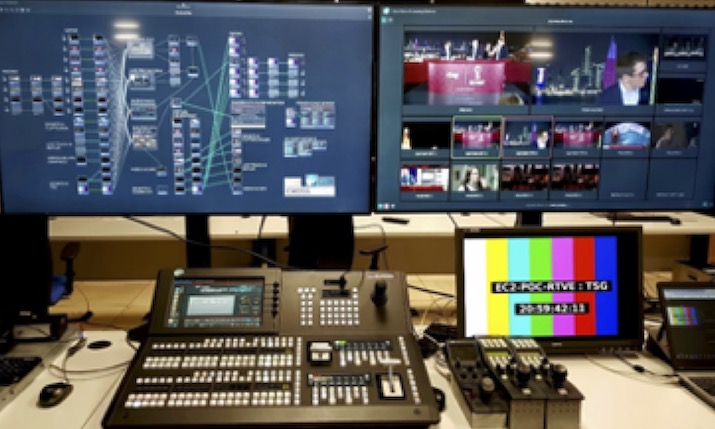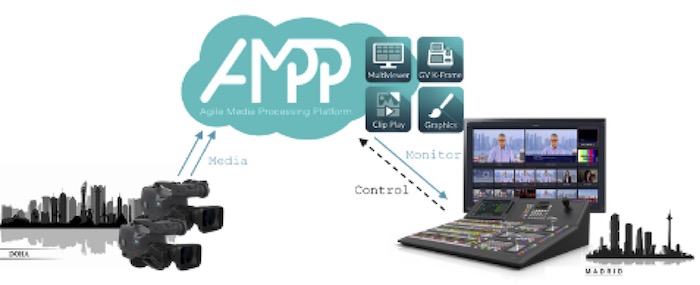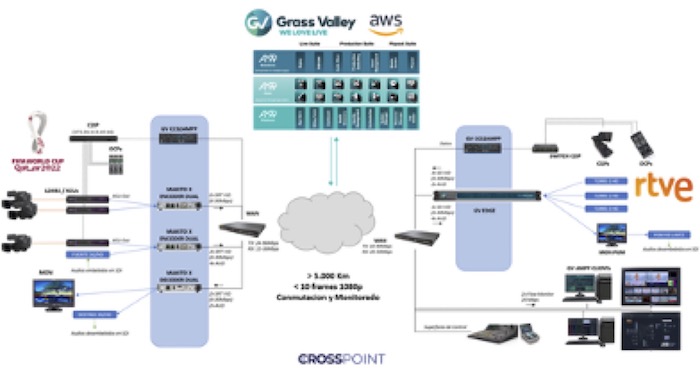RTVE on its proof of concept for public cloud production with GV AMPP at Qatar World Cup 2022

By Manuel González Molinero and Jesús García Romero, TVE (Televisión Española)
Major world events are often excellent opportunities to test new technological solutions. Many of them aim to develop and carry out productions in a more sustainable and efficient way, reducing costs and increasing operational benefits. The Media and Operations Department of RTVE (Radiotelevisión Española) explored new paths of innovation with the most advanced technologies during the Qatar 2022 World Cup.
In parallel to its traditional production, RTVE carried out a proof of concept (POC) using Grass Valley’s AMPP Agile Media Processing Platform. The main objective was to test a remote production with broadcast solutions based on software and connected through the public internet with processing in the public cloud.
Committed to addressing this technological challenge, Grass Valley and channel partner Crosspoint stood as dedicated technical team partners for RTVE. In less than a week, they set up and installed an operations and production control room – as well as a cloud-based production system – in the Torrespaña broadcast center.
The remote production POC used the RTVE Skyline set on the terrace of one of Doha’s skyscrapers, taking advantage of the signals from the cameras at that location. To convert the camera’s SDI signals into SRT video streams and share them to the cloud, RTVE relied on Haivision’s Makito encoders, utilising a local FTTH connection with a capacity of approximately 100Mb/s.
The audio from the presenters and from Doha was embedded in the XCU inputs of the cameras installed in the Skyline and transported to the cloud within the SRT video stream, allowing individual control of each channel by the application on the cloud platform.
In Torrespaña, another FTTH provided connection to Grass Valley Korona video switcher panels, OCP400/CGP500 for remote control of camera parameters and to a LiveTouch video replay panel. All other functions required for the technical production, such as a multiviewer, audio mixer, graphics control, workflow control and management were executed by applications running on the AMPP platform that were deployed via software on computers installed in the same control room.
All necessary processes and computing were hosted in an instance configured for this purpose in the public cloud. The applications running in the cloud did not require any additional hardware: no video mixer core, no multiviewer, no replay server.

Camera control and monitoring were managed from the cloud platform with CCS-One servers installed for this purpose on the Doha set and with the corresponding grading application, allowing intuitive camera control remotely and multicamera monitoring switched from physical control panels themselves. This application also served the function of tally, both in Torrespaña’s camera controls as well as in the multiviewer application accessible from any terminal with internet access and, of course, in the cameras located more than 5,000km (3,100 miles) away.
The processing in the public cloud for video mixing and effects was handled by another application of the ecosystem that allows using up to 32 inputs and 16 outputs in 1080p with three M/E processing banks and six keyers per bank, including memory for stored clips, 2D effects and multiviewer. The instance deployed in the cloud was controlled from the physical mixer panel located in the Torrespaña control room. Graphics, using the official RTVE visual identity guidelines, were created by importing the graphic templates and another application was used for the different banners and logos.
The recording and playback of content was also managed with cloud-based applications. The ingest and replay management system used had the capacity for synchronised ingest of four video sources and playback of two independent programs with signaling, positioning and playback speed control tools. The media storage was also hosted in the cloud and associated with the processing instances and was controlled either directly by software with one of the applications of the system platform or through the physical panel installed in the control room, since the operators were not very familiar with it.
Another application performed the monitoring and multiviewer function in the cloud. It enabled the creation of several screen models with different window sizes and configurations according to the needs and requests of the different professionals participating in the tests.
For the exchange of signals between the SDI environment of Torrespaña and the SRT streams of the public cloud, an AMPP Edge server was installed, allowing a very low latency connection with the cloud. In the same way, this equipment made it possible to incorporate SDI video sources from TVE’s central control to the production. The Edge server also allowed the use of the various applications of the ecosystem in the server itself locally, allowing the use of hybrid scenarios with processing located in different physical locations or in the cloud.
This basic schematic of the remote production POC shows that all the processing was deployed in the public cloud, while all the control and operation applications and panels were installed in the Torrespaña control room, simulating an operational process similar to those usually performed. Regarding the technical scheme, it is possible to identify the different zones, the RTVE set in Qatar, the processing applications deployed in the public cloud and all the operation and control deployment in the Madrid control room.

The result of this POC implementation was a success. RTVE intended to test it in a real environment before possible operational deployment. Despite exchanging signal sources between locations more than 5,000km away, synchronisation was good. Monitoring and switching latencies below 10 frames were achieved at 1080p. This latency is similar and even lower than what can be achieved through a satellite connection and with proven quality in 1080p format. The cloud platform enabled accurate, synchronous switching, with audio and video correctly aligned, and performing advanced effects and DVE. As added proof, a mobile phone camera located in Madrid with an SRT output was connected as another remote source, allowing it to be used synchronously with the sources from Qatar.
All the players involved in this production took great advantage of the opportunity in an active and effective way. TVE was able to get to know this solution in depth, and most of the engineers and technicians from TVE’s Media and Operations Department had the chance to visit the control room installed in Torrespaña, where they learned about the features of the tested solution and the characteristics of cloud computing.
Also, operators of different profiles such as video mixers, directors, audio operators, camera controllers and replay operators also visited the installations. From an operational point of view, they were all able to interactively test the features of this new technology and provide feedback on the features and functionalities required in daily work and operation.
From RTVE’s point of view, after testing the production in the cloud using public internet connections and seeing the evolution of the new solutions available in the market, it is obvious that most productions will evolve in this direction in the near future.
For the time being, RTVE will use it for events where there is a large on-site production, and to complement it with some extra camera control, some alternative production, or some additional replay system.
For upcoming events, RTVE will continue to explore the features, advantages and opportunities offered by remote production systems in the cloud.

